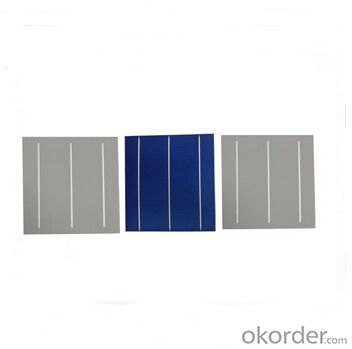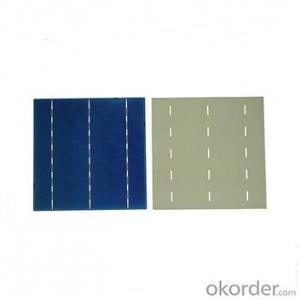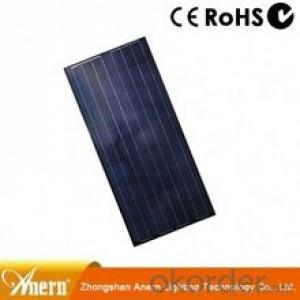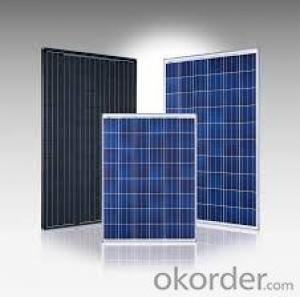Polycrystalline Solar Cell High Quality 17.00%-18.20% Effy
- Loading Port:
- Shanghai
- Payment Terms:
- TT OR LC
- Min Order Qty:
- 1000 pc
- Supply Capability:
- 1000000 pc/month
OKorder Service Pledge
OKorder Financial Service
You Might Also Like
Solar Cells:
solar cells, when struck by photons of light from the sun, generates an electrical current which can then be used to power DC or AC electrical loads.
A solar cell is made of silicon. Computer chips are made of this same material. Basically, when light strikes the surface of a solar cell some of it is absorbed into the silicon. This light energy bumps the electrons loose and causes energy to flow
Solar cells is made by solar wafer, it has three categories of solar cell right now, monocrystalline polycrystalline and thin film,These cells are entirely based around the concept of PN junction, which is the critical part of solar module, it is the part that can convert the light energy into electricity, the thickness is from 180um to 200um, with even busbars to conduct electricity, textured cell can decrease diffuse reflection; they are often electrically connected and encapsulated as a module. Photovoltaic modules often have a sheet of glass on the front (sun up) side, allowing light to pass while protecting semiconductor wafers from abrasion and impact due to wind-driven debris, rain, hail, etc. Solar cells are also usually connected in series in modules, creating an additive voltage. Connecting cells in parallel will yield a higher current;With high quality and stable quality. Our Cells can greatly improve the performance of Solar Modules.
Specifications
fficiency code | 182 | 180 | 178 | 176 | 174 | 172 | 170 | |
Efficiency | Eff(%) | 18.20 | 18.00 | 17.80 | 17.60 | 17.40 | 17.20 | 17.00 |
Power | Ppm(W) | 4.43 | 4.38 | 4.33 | 4.28 | 4.23 | 4.19 | 4.14 |
Max. Power current | Ipm(A) | 8.26 | 8.22 | 8.17 | 8.12 | 8.08 | 8.05 | 7.99 |
Short Circut Current | Isc(A) | 8.71 | 8.68 | 8.63 | 8.60 | 8.56 | 8.53 | 8.49 |
Max. Power Voltage | Vpm(V) | 0.536 | 0.533 | 0.530 | 0.527 | 0.524 | 0.521 | 0.518 |
Open Cirtuit Voltage | Voc(V) | 0.634 | 0.632 | 0.630 | 0.627 | 0.625 | 0.622 | 0.620 |
Solar Cells Advantage:
• High efficiency and stable performance in photovoltaic conversion.
• Advanced diffusion technique ensuring the homogeneity of energy conversion efficiency of the cell.
• Advanced PECVD film forming, providing a dark blue silicon nitride anti-reflection film of homogenous color and attractive appearance.
• High quality metal paste for back surface and electrode, ensuring good conductivity, high pulling strength and ease of soldering.
• High precision patterning using screen printing, ensuring accurate busbar location for ease with automatic soldering a laser cutting.
Features:
High efficiencies up to 16.4%
Proven long term mechanical stability of silicone
Make of highly purified poly silicone
Three bus bars for reduced series resistance and improved module and cell efficiency
Blue anti-reflecting coating ensures improved light absorption and increased efficiency
Acid texturization offers a uniform appearance and virtually invisible crystal structure
Excellent low light behavior for improved energy yield

FAQ
We have organized several common questions for our clients,may help you sincerely:
①What price for each watt?
It depends on the efficiency of the solar cell, quantity, delivery date and payment terms.
②How long can we receive the product after purchase?
In the purchase of product within three working days, We will arrange the factory delivery as soon as possible. The pecific time of receiving is related to the state and position of customers.Commonly 7 to 10 working days can be served.
③Can you provide the peripheral products of the solar panels, such as the battery, controller, and inverter? If so, can you tell me how do they match each other?
Yes, we can, we have two companies for solar region, one is CNBM International, the other is CNBM engineering Co.
We can provide you not only the solar module but also the off grid solar system, we can also provide you service with on grid plant.
④What is your warranty of solar cell?
Our product can promise lower than 0.3% open box crack, we support claim after opening the box if it has crackm color difference or sth, the buyer should give pictures immediately, we can not accept the claim after the solar cell has assembled to solar panel.
• Timeliness of delivery
• ⑤How do you pack your products?
We have rich experience on how to pack the solar cell to make sure the safety on shipment, we could use wooden box or pallet as buyer's preference.
- Q:Where can I buy solar cells on sale but still good quality ?
- Sometimes you can find a good deal with the local manufacturers, where they sell some good quality solar cells at a pretty good price.
- Q:How do solar cells compare to fossil fuel-based power generation?
- Solar cells have several advantages over fossil fuel-based power generation. Firstly, solar cells generate electricity by harnessing sunlight, which is a renewable and abundant source of energy, whereas fossil fuel-based power generation relies on finite and polluting resources like coal, oil, and gas. Additionally, solar cells have a significantly lower environmental impact as they produce no greenhouse gas emissions during operation. Solar cells also require less maintenance and have a longer lifespan compared to fossil fuel power plants. However, solar cells have limitations such as intermittent power generation and higher initial costs, but advancements in technology are addressing these challenges. Overall, solar cells offer a cleaner, more sustainable, and increasingly cost-effective alternative to fossil fuel-based power generation.
- Q:What is the impact of snow accumulation on solar cells?
- Snow accumulation on solar cells can have a negative impact on their performance and efficiency. The layer of snow covering the cells prevents sunlight from reaching the surface, reducing the electricity generation capacity. Additionally, the weight of the snow can potentially damage the cells or the supporting structure. Regular cleaning or tilting of the panels can minimize the impact and ensure optimal solar energy production.
- Q:Can solar cells be used in traffic management systems?
- Yes, solar cells can be used in traffic management systems. Solar cells can be integrated into traffic lights, road signs, and other traffic management devices to power them using renewable energy. This helps reduce dependence on the traditional electrical grid, lowers energy costs, and promotes sustainability in traffic management systems.
- Q:How do solar cells handle fluctuating sunlight intensity?
- Solar cells handle fluctuating sunlight intensity through a process called maximum power point tracking (MPPT). MPPT technology ensures that solar cells are able to continuously optimize their performance and output power by constantly adjusting the electrical load to match the varying sunlight conditions. This allows solar cells to efficiently convert sunlight into electricity, even when the intensity of sunlight changes throughout the day or due to weather conditions.
- Q:Can solar cells be used in recreational vehicles?
- Yes, solar cells can be used in recreational vehicles. Installing solar panels on RVs allows them to harness the power of the sun to generate electricity, which can be used to charge batteries and power appliances while on the road. This helps to reduce reliance on traditional power sources, making RVs more energy-efficient and environmentally friendly.
- Q:What materials are commonly used to make solar cells?
- The most commonly used materials to make solar cells are silicon, cadmium telluride, and copper indium gallium selenide.
- Q:How do solar cells perform in high humidity environments?
- Solar cells typically perform well in high humidity environments. However, excessive moisture or prolonged exposure to water can lead to a decrease in their efficiency. It is important to ensure proper waterproofing and maintenance of the solar panels to prevent any potential damage caused by moisture.
- Q:Can solar cells be used on windows?
- Yes, solar cells can be used on windows.
- Q:How do solar cells affect the local ecosystem?
- Solar cells have a minimal impact on the local ecosystem compared to traditional energy sources. They produce clean and renewable electricity, reducing the reliance on fossil fuels and their associated pollution. While the manufacturing and disposal of solar cells may have some environmental impact, it is far outweighed by the benefits of using solar energy, such as reduced greenhouse gas emissions and improved air and water quality. Additionally, solar installations can provide habitat for certain wildlife species and contribute to the preservation of natural landscapes. Overall, solar cells have a positive effect on the local ecosystem by promoting sustainability and mitigating climate change.
1. Manufacturer Overview |
|
|---|---|
| Location | |
| Year Established | |
| Annual Output Value | |
| Main Markets | |
| Company Certifications | |
2. Manufacturer Certificates |
|
|---|---|
| a) Certification Name | |
| Range | |
| Reference | |
| Validity Period | |
3. Manufacturer Capability |
|
|---|---|
| a)Trade Capacity | |
| Nearest Port | |
| Export Percentage | |
| No.of Employees in Trade Department | |
| Language Spoken: | |
| b)Factory Information | |
| Factory Size: | |
| No. of Production Lines | |
| Contract Manufacturing | |
| Product Price Range | |
Send your message to us
Polycrystalline Solar Cell High Quality 17.00%-18.20% Effy
- Loading Port:
- Shanghai
- Payment Terms:
- TT OR LC
- Min Order Qty:
- 1000 pc
- Supply Capability:
- 1000000 pc/month
OKorder Service Pledge
OKorder Financial Service
Similar products
New products
Hot products
Hot Searches
Related keywords



























